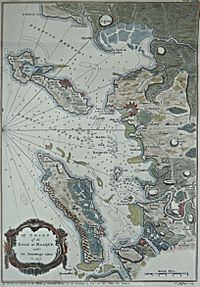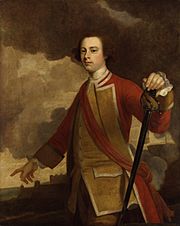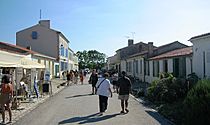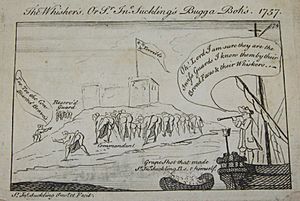Raid on Rochefort facts for kids
Quick facts for kids Raid on Rochefort |
|||||||
|---|---|---|---|---|---|---|---|
| Part of Seven Years' War | |||||||
 British chart of the Basque Roads, 1757. |
|||||||
|
|||||||
| Belligerents | |||||||
| Commanders and leaders | |||||||
| John Mordaunt Edward Hawke James Wolfe |
Joseph-Marie Budes de Guébriant Du Pin de Belugard Comte de Langeron |
||||||
| Strength | |||||||
| 10,000 Troops Seventeen Ships of the Line Dozens of Auxiliary Ships |
3,000 Two Gunboats |
||||||
The Raid on Rochefort was a British attempt to capture the French port of Rochefort in September 1757. This event happened during the Seven Years' War, a big conflict between powerful European countries. The raid was a new kind of attack, called a "descent," where soldiers would land from ships to surprise the enemy on their coast. This idea was strongly supported by William Pitt, who had just become a leader in the British government.
After some delays, the British ships reached the French coast. They managed to capture a small island nearby called Île d'Aix. However, the army commander, Sir John Mordaunt, decided not to land his troops on the mainland. Because of this, the British force eventually sailed back home. The raid was a failure, but it led to other similar attacks on the French coast in the years that followed.
Contents
Why the Raid Happened
Britain had a tough start in the Seven Years' War. They lost battles to the French in North America. Also, their important naval base in the Mediterranean Sea, Menorca, was captured by French forces. At the same time, Britain's ally, Hanover, was being invaded by the French.
Because of these losses, a new British government was formed in July 1757. William Pitt was a key figure in this new government. Pitt wanted to make a bold move. He hoped to force France to send many of its soldiers, who were planning to invade Germany, to protect their own coast from British attacks. He also wanted to make the British public happy, as they were asking for such a campaign.
Britain's main ally, Frederick the Great of Prussia, also urgently asked for this kind of attack. He believed it would help his armies and another allied army that was facing a French attack. Frederick thought that raids on the French coast would take pressure off his forces.
The city chosen for the attack was Rochefort. A British engineer named Captain Robert Clerk had said that Rochefort was not well-protected and could be easily surprised by a British attack. Pitt got permission for the raid from King George II and the Duke of Newcastle. Even though they had doubts, they agreed to the plan. Later, as the situation in Hanover got worse, they asked Pitt to send the expedition to a German port instead. But Pitt refused to change the target.
Getting Ready and the Journey
Sir John Mordaunt was chosen to lead the soldiers. Edward Cornwallis and Henry Conway were his main assistants. Edward Hawke was in charge of the navy. His job was to take Mordaunt's troops to France, help them land, and then pick them up when the mission was done. James Wolfe was a very important officer, acting as the army's chief of staff.
The expedition gathered on the Isle of Wight in July and August 1757. There were many delays, which pushed back their departure date. Most officers spent their time in Newport. About 8,000 soldiers were camped there. To keep the plan secret from French spies, only the most senior officers knew where they were going.
On September 7, a month later than planned, the force finally sailed from Britain. They headed towards the Bay of Biscay. They arrived near Rochefort on September 20. However, thick fog kept them from landing for several days. The naval officers, especially Hawke, were worried about the weather getting worse. They feared strong autumn storms that would make the sea very dangerous.
Landing on Île d'Aix
A French guide named Joseph Thierry helped two British warships get close to the fort on Île-d'Aix. The fort's guns were silenced by the powerful cannons of HMS Magnanime, commanded by Captain Richard Howe. Soon, HMS Barfleur joined in. Within two hours, the island was captured by the British. This island was seen as a very important first step for any attack on Rochefort.
From Île d'Aix, Wolfe looked at the mainland. He noticed a battery of guns at Fort Fouras, which protected the mouth of the Charente River. The French were completely unprepared for an attack and were surprised by the British fleet. Wolfe suggested attacking Fort Fouras right away. He also thought they should make a small attack near La Rochelle to confuse the French. Mordaunt agreed to attack Fort Fouras. But then he had to cancel it because the water around the fort was too shallow for Hawke's ships to get close enough to fire their cannons.
On September 25, Mordaunt held a meeting with his officers. They decided that the earlier ideas about how weak the French defenses were at Rochefort were wrong. They were especially unsure about the ditch around Rochefort. If it was filled with water, it would be impossible to climb over. So, they decided that trying to capture Rochefort was "not a good idea or possible." Wolfe kept pushing for a new attack, even though the element of surprise was gone. But Mordaunt was still unsure.
They still hoped to bother the French forces. General Conway encouraged Mordaunt to think about attacking Fouras again. This was finally agreed upon at another meeting on the morning of September 28. A landing spot near Chatelaillon was chosen. However, Mordaunt was worried that large French forces might be hiding behind the sand dunes. The troops got into the landing boats late that night. But a strong wind came up, and with the tide, it made them worry about how long it would take to send more troops to help the first wave. The landing was cancelled.
Going Back Home

Hawke was tired of the General's hesitation. He gave Mordaunt an ultimatum: if the army wasn't going to land, he would take the navy back to Britain. Faced with this, Mordaunt decided that another immediate attack was not possible. He agreed that the force should leave. Before leaving, they destroyed the defenses on Île d'Aix.
On October 1, the force left Rochefort and arrived back in England on October 6. Mordaunt said he made the decision because the navy was needed to protect against a French fleet coming from the West Indies, rather than waiting around Rochefort. Many officers who were part of the operation quickly criticized Mordaunt's decision. They believed a landing was still possible, even without the surprise factor. Wolfe and Howe were praised for their efforts. The failure at Rochefort was compared to other military setbacks.
What Happened Next
The failure of the expedition led to an investigation. It was suggested that Mordaunt should face a military trial, which began on December 14. Even though many people wanted him to be found guilty, Mordaunt was found not guilty. The court decided that the mission itself had been poorly planned. King George II was very angry about this decision, believing Mordaunt should have been removed from his position. Pitt was also annoyed, as the verdict suggested he was largely to blame for the failure and criticized the idea of coastal raids. The expedition cost a lot of money, about a million pounds, which was a huge amount back then.
Even so, Pitt still believed in the idea of raiding the French coast. The next year, Britain launched more "descents." These included a planned attack on Saint-Malo that was stopped, and a short occupation of Cherbourg. One unexpected result of the Rochefort raid was that it made the route into Rochefort unsafe for French trade ships coming from the West Indies. This forced them to go to Brest instead, where British warships on patrol could more easily capture them.
The bay near Rochefort later became the site of another battle, the Battle of the Basque Roads, in 1809.
See also




